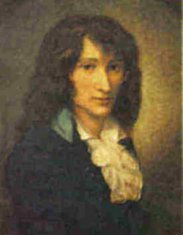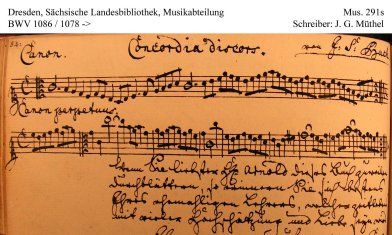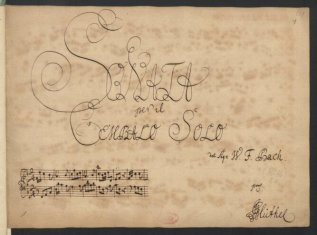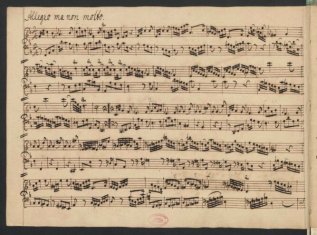|
|
Johann Gotffried Müthel (Composer, Organ, Keyboard, Copyist, Bach's Pupil) |
|
Born: January 17, 1728 - Mölln, near Lauenburg, about 30 km south of Lübeck, Schleswig-Holstein, Germany
Died: July 14, 1788 - Bienenhof, near Riga, Latvia |
|
Johann Gottfried Müthel was a German composer, organist and noted keyboard virtuoso. Along with Carl Philipp Emanuel Bach, he represented the Sturm und Drang style of composition.
Johann Gottfried Müthel was born in Mölln in the Duchy of Lauenburg, the fifth of nine children. His father was Christian Caspar Müthel, an organist at the Nikolaikirche and friend of Georg Philipp Telemann. He studied music with his father, and later Johann Paul Kunzen in Lübeck. In 1747, at age 19, he became a court organist and harpsichordist for Duke Christian Ludwig II of Mecklenburg-Schwerin, in Schwerin.
In 1750 J.G. Müthel was given leave to study with J.S. Bach in Leipzig. He became J.S. Bach's last pupil, beginning study only three months before the master's death. In that time, he notated a number of the blind composer's final works, including the Chromatic Fantasia (BWV 903) and parts of the Orgelbüchlein. According to J.S. Bach's biographer Philipp Spitta, he was present at J.S. Bach's deathbed, and took over his duties for nine weeks. Afterwards, he continued study with Johann Christoph Altnikol, who had also been living and studying with J.S. Bach. After J.S. Bach's death, he stayed in Naumburg, Dresden, Potsdam/Berlin and Hamburg, and took the opportunity to travel and meet other composers, the most notable of whom was C.P.E. Bach (then residing at the court of Frederick II of Prussia at Potsdam), with whom he maintained a lifelong friendship and correspondence. In 1751 he returned to the ducal court, where he remained for two more years, eventually being replaced by his younger brother.
J.G. Müthel is believed to have been a skilled improviser on the keyboard. He seems to have preferred the clavichord. He gained praise from a number of musicians for his virtuosity. The English music historian Charles Burney, who mentioned him several times in his writings, held him in high esteem. The German Christian Friedrich Daniel Schubart wrote of his harpsichord skill that "connoisseurs that have heard him cannot praise enough the quickness, correctness and lightness with which he conquers mountains of difficulties."
In 17531 3 or 17552 J.G. Müthel moved to Riga (now in Latvia, then part of the Russian Empire), where one of his brothers had moved. Hae became there Kapellmeister (conductor) with Otto Hermann von Vietinghoff. He remained in Riga for the rest of his life. It was here that he published his first works, in 1756; he only published a few works in his lifetime. At first he worked as a Kapellmeister to a small musical establishment (a private orchestra); later, he was appointed organist at St. Peter's Church, which he served from 1767 (previously as adjunct) until 1788, when he died in nearby Bienenhof.
Johann Gottfried Müthel's planned trip to J.S. Bach in 1750 from his appointment as court organist is documented in Schwerin court files. In a letter to Forkel (1775), Burney (1773) and C.P.E. Bach testify that the lessons actually came about. A number of other authors (Heck 1775, von Murr 1776, Meusel 1789, Gerber 1790) certainly built on Burney's publication. It is only in the German translation of Burney's writing that an addendum, probably from Christoph Daniel Ebeling, is included, which addresses Müthel's recording in J.S. Bach's house
Johann Gottfried Müthel's works are predominantly instrumental. Some show J.S. Bach's influence, others are almost wilfully original in style. As far as is known, he was the first to use the term fortepiano in a published work, in the title of his Duetto für 2 Clavier, 2 Flügel, oder 2 Fortepiano (1771), which reflects the rising popularity of the fortepiano at that time.
References: Koska: A-61; GND: 118735128; Bach Digital: 00000744 |
| |
|
Compositions |
|
Most of his works remained unpublished in his lifetime, and some known works are still without official publication. None of the works for his principal instrument, the organ, were published in his lifetime, nor were any for non-keyboard instruments.
For keyboard:
His known works include a total of seven concerti, nine sonatas, and numerous other shorter pieces.
Concerto in B flat major (1767)
Concerto for Harpsichord in D minor (1767)
Sonata No. 1 in F major (1756)
Sonata No. 2 in G major (1756)
Sonata No. 3 in C major (1756)
Duetto für 2 Clavier, 2 Flügel, oder 2 Fortepiano (1771)
Duetto in E-flat major (1771)
Arioso with 12 Variations, No. 1 in G major (1756)
Arioso with 12 Variations, No. 2 in C minor (1756)
12 Variations for Clavichord
Minuet with 6 variations
Tempo di Minuetto con Variazioni
Fantasy in F for Organ
For voice:
45 Choice Odes and Songs from Various Poets (45 Auserlesene Oden und Lieder van verschiedenen Dichtern) (1759)
A cantata
For other instruments:
Concerto for Bassoon in C major
Concerto for 2 Bassoons in E-flat major
Sonata in D major for Flute and Basso Continuo |
|
Works of Bach he copied [Manuscript No. in Bach Digital / Work / Performance/Copy date] |
|
B-Bc 27887 MSM: Wq 65.11; H 21
D-B Mus. O. 12172 Rara, Teil 2 (handschriftlicher Anhang): Durch Adams Fall; Jesu, meine Freude; Vater unser im Himmelreich
D-B Mus.ms. Bach P 218, Faszikel 2: BWV 964, BWV 968: title and incipit 964 [c1750]
D-B Mus.ms. Bach P 230, Faszikel 2: BR-WFB A 11b; Fk 6B
D-B Mus.ms. Bach P 275, Faszikel 5: BWV 903/1, BWV 906/1; Wq 65.13; BR-WFB A 7
D-B Mus.ms. Bach P 366 [Konvolut]: Wq 65.23, 70.6, 62.17, 70.4, 161.1, 161.2; H 57, 87, 117, 85, 579, 578
D-B Mus.ms. Bach P 367: Wq 163 (2), 149, 148, 151, 233.16 (n.v. 10), n.v. 35, 118.2, 113.1, 113.2, 113.3, 113.4, 63.1, 63.2, 63.3, 62.10, 65.10, 62.8, 62.6, 65.16, 65.9; H 588 (2) [= 589], 573, 572, 575, 776, 350, 155, 193, 194, 195, 196, 70, 71, 72, 59, 19, 55, 40, 46, 18; BWV Anh. 187
D-B Mus.ms. Bach P 815: BWV 829/4, BWV 826/1 (T. 1-7)
D-B Mus.ms. Bach St 134: BWV 1044 [between 1750 and 1753]
D-B Mus.ms. Bach St 218: Wq 8; H 411; BR-CPEB C
D-Dl Mus. 291 s [Bd. 1]: BWV 1086 / 1078->, 548/2 (T. 1-16) |
 |

|
|
Portrait [01] |
Handwriting sample (Bach Digital) [HW-01]
|
|

|

|
|
Handwriting sample (c1750)
(Staatsbibliothek zu Berlin) [HW-02] |
Handwriting sample (c1750) (Staatsbibliothek zu Berlin)
[HW-02] |
|
Sources:
1. Wikipedia Website
2. Malcom Boyd, editor: Oxford Composer Companion J.S. Bach (Oxford University Press, 1999)
3. Bernd Koska: Bachs Privatschüler in Bach-Jahrbuch 2019, English translation by Aryeh Oron (May 2020)
4. Bach Digital Website (January 2020)
Contributed by Aryeh Oron (November 2008, May 2020) |
|
Works previously attributed to J.S. Bach |
|
Sonata for keyboard in D minor, BWV 964 [arrangement of Sonata for violin solo No. 2 in A minor, BWV 1003, possibly by J.G. Müthel] |
|
Use of Chorale Melodies in his works |
|
Jesu meine Freude , Chorale for Organ (CM: Jesu, meine Freude) |
|
Chorale Prelude for organ Was mein Gott will, das gscheh allzeit (CM: Was mein Gott will, das g’scheh allzeit) |
|
Links to other Sites |
|
Johann Gottfried Müthel (Wikipedia)
HOASM: Johann Gottfried Müthel
Liner notes from clavichord recording, by Peter Reidemeister
Johann Gottfried Müthel (Answers.com)
Johann Gottfried Müthel (Hutchinson Encyclopedia)
Analysis of Concerto for 2 Bassoons in E-flat
Müthel, Johann Gottfried (Bach digital) |
|
Bibliography |
|
Sources 3: Dok II, Nr. 602, 603; Dok III, Nr. 777, 803, 818, 829, 950; Dok VII, S. 55; Löffler 1929/31, Nr. 55; Löffler 1953, Nr. 74; MGGo; Z. Gailíte, Johann Gottfried Müthel, die Bach-Familie und die „Wahre Art, das Clavier zu spielen“ in Riga, in: Die Verbreitung der Werke Carl Philipp Emanuel Bachs in Ostmitteleuropa im 18. und 19. Jahrhundert, hrsg. von U. Leisinger und H.-G. Ottenberg, Frankfurt/Oder 2002 (Carl-Philipp-Emanuel-Bach-Konzepte. Sonderband. 3,2.), S. 480–489 |
|
|